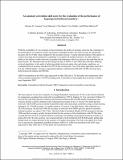| dc.contributor.author | Blackwell, William J. | |
| dc.contributor.author | Aumann, Hartmut H. | |
| dc.contributor.author | Manning, Evan | |
| dc.contributor.author | Barnet, Chris | |
| dc.contributor.author | Maddy, Eric | |
| dc.date.accessioned | 2010-03-18T19:28:05Z | |
| dc.date.available | 2010-03-18T19:28:05Z | |
| dc.date.issued | 2009-08 | |
| dc.identifier.issn | 0277-786X | |
| dc.identifier.uri | http://hdl.handle.net/1721.1/52725 | |
| dc.description.abstract | With the availability of very accurate six hour forecasts, the metric of accuracy alone for the evaluation of the performance of a retrieval system can produce misleading results: the retrievals may be statistically accurate, but be of little value compared to the accurate forecast. A useful characterization of the quality of a retrieval system and its potential to contribute to an improved weather forecast is its skill, which we define as the ability to make retrievals of geophysical parameters which are closer to the truth than the six hour forecast. We illustrate retrieval skill using one day of AMSU-A and AIRS data with three different retrieval algorithms. In the spirit of achieving global retrievals under clear and cloudy conditions, we evaluated retrieval accuracy and skill for 90% of the covered area. Two of the three algorithms meet the 1 K/1 km "RAOB quality" accuracy requirement and have skill between 900 and 150 hPa, but none have skill between the surface and 900 hPa. AIRS was launched on the EOS Aqua spacecraft in May 2002 into a 705 km polar sun-synchronous orbit with accurately maintained 1:30 PM ascending node. Essentially un-interrupted data are freely available since September 2002. | en |
| dc.description.sponsorship | United Sates Air Force (contract FA8721-05-C-0002) | en |
| dc.description.sponsorship | National Aeronautics and Space Administration | en |
| dc.language.iso | en_US | |
| dc.publisher | The International Society for Optical Engineering | en |
| dc.relation.isversionof | http://dx.doi.org/10.1117/12.826990 | en |
| dc.rights | Article is made available in accordance with the publisher's policy and may be subject to US copyright law. Please refer to the publisher's site for terms of use. | en |
| dc.source | SPIE | en |
| dc.title | An anomaly correlation skill score for the evaluation of the performance of hyperspectral infrared sounders | en |
| dc.type | Article | en |
| dc.identifier.citation | Aumann, Hartmut H. et al. “An anomaly correlation skill score for the evaluation of the performance of hyperspectral infrared sounders.” Atmospheric and Environmental Remote Sensing Data Processing and Utilization V: Readiness for GEOSS III. Ed. Mitchell D. Goldberg & Hal J. Bloom. San Diego, CA, USA: SPIE, 2009. 74560T-7. © 2009 SPIE--The International Society for Optical Engineering | en |
| dc.contributor.department | Lincoln Laboratory | en_US |
| dc.contributor.approver | Blackwell, William J. | |
| dc.contributor.mitauthor | Blackwell, William J. | |
| dc.relation.journal | Proceedings of SPIE--the International Society for Optical Engineering; v.7456 | en |
| dc.eprint.version | Final published version | en |
| dc.type.uri | http://purl.org/eprint/type/JournalArticle | en |
| eprint.status | http://purl.org/eprint/status/PeerReviewed | en |
| dspace.orderedauthors | Aumann, Hartmut H.; Manning, Evan; Barnet, Chris; Maddy, Eric; Blackwell, William | en |
| mit.license | PUBLISHER_POLICY | en |
| mit.metadata.status | Complete | |
